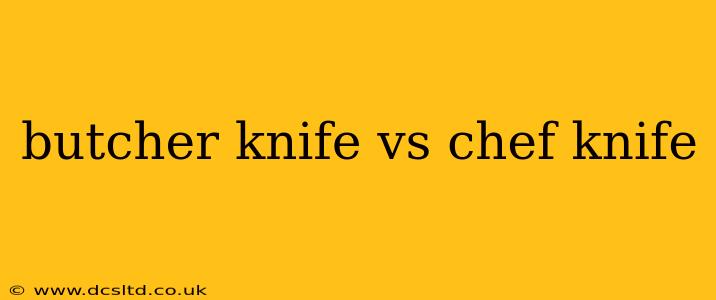Choosing between a butcher knife and a chef's knife often leaves home cooks and professional chefs alike scratching their heads. Both are essential kitchen tools, but their distinct designs cater to different needs. Understanding these differences is key to selecting the right knife for your culinary endeavors. This comprehensive guide delves into the specifics, helping you determine which blade best suits your kitchen and cooking style.
What is a Butcher Knife?
A butcher knife, also known as a breaking knife, is characterized by its long, narrow blade with a pointed tip. Typically ranging from 6 to 15 inches in length, this blade is exceptionally sturdy, often forged from high-carbon steel for superior durability. Its strength lies in its ability to cleanly sever bones and cartilage, making it ideal for processing large cuts of meat. The pointed tip allows for precision when trimming fat or separating joints.
Key Features of a Butcher Knife:
- Long, narrow blade: Provides leverage for cutting through tough materials.
- Pointed tip: Facilitates precise cuts and piercing.
- Thick blade: Ensures strength and durability for bone-cutting tasks.
- Typically heavier: Provides stability and control during demanding cuts.
What is a Chef's Knife?
The chef's knife, a cornerstone in any kitchen, is a versatile tool boasting a curved blade typically ranging from 8 to 14 inches. This curve, known as a "sheep's foot" or "drop point" blade, facilitates a rocking motion that's perfect for chopping, dicing, mincing, and slicing various ingredients. While it can handle meat, its primary function is general food preparation, making it a workhorse for everyday cooking.
Key Features of a Chef's Knife:
- Curved blade: Allows for a rocking motion, increasing efficiency in chopping and slicing.
- Versatile: Suitable for a wide range of tasks, from chopping vegetables to slicing meat.
- Usually lighter than a butcher knife: Allows for greater maneuverability.
- More balanced: Offers better control for detailed work.
Butcher Knife vs. Chef Knife: Which is Right for You?
The ideal choice hinges on your culinary needs and frequency of use.
- Choose a butcher knife if: You frequently work with large cuts of meat, bone-in poultry, or need to break down carcasses. Its strength and pointed tip are invaluable for these tasks.
- Choose a chef's knife if: You require a versatile all-purpose knife for general food preparation. Its curved blade excels at a wide array of chopping, slicing, and dicing tasks.
What are the Different Types of Butcher Knives?
While the standard butcher knife is well-known, variations exist based on specific needs:
- Slicing Butcher Knife: Features a longer, thinner blade for slicing already-cut meat.
- Breaking Knife: Often shorter and more robust for breaking down bones effectively.
What are the Different Types of Chef Knives?
Similar to butcher knives, chef's knives come in various forms:
- Japanese Chef's Knife (Gyuto): Usually lighter and thinner than Western chef's knives, emphasizing precision and control.
- Chinese Chef's Knife (Cai Dao): Characterized by its rectangular shape and thin blade, making it exceptionally efficient for chopping vegetables.
Can a Chef's Knife Replace a Butcher Knife?
While a chef's knife is incredibly versatile, it cannot entirely replace a butcher knife. Attempting to cut through bone with a chef's knife risks damaging the blade or causing injury.
Can a Butcher Knife Replace a Chef's Knife?
Conversely, a butcher knife is less suitable for the precise and delicate work a chef's knife excels at. While it can chop vegetables, it's less efficient and comfortable for such tasks.
Which Knife is Better for Beginners?
For beginners, a high-quality chef's knife is generally recommended. Its versatility makes it a more practical starting point. Mastering its use will cover most everyday kitchen tasks. A butcher knife can be added later as culinary skills advance and the need arises.
Ultimately, the "better" knife depends on your specific needs. Consider your culinary habits and choose the blade that best supports your cooking style. Both knives serve vital roles in the kitchen; selecting the right tool for the right job is paramount to achieving culinary success.
